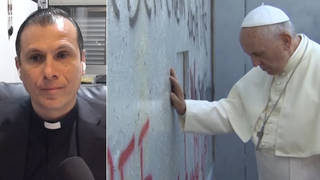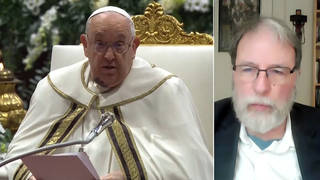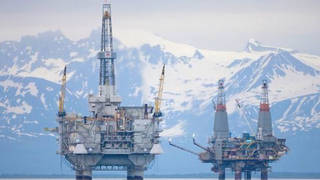
Topics
Guests
- Jason Boxprofessor in glaciology at the Geological Survey of Denmark and Greenland.
Links
Scientists are expressing dismay over unprecedented warm temperatures in the Arctic. In recent days, temperatures at the North Pole have surged above freezing—even though the sun set last October and won’t rise again until later this month. On the northern tip of Greenland, a meteorological site has logged an unprecedented 61 hours of temperatures above freezing so far in 2018. The record-breaking temperatures are connected to an unusual retreat of sea ice in the sunless Arctic winter. Scientists suggest warming temperatures are eroding the polar vortex, the powerful winds that once cushioned the frozen north. The alarming heat wave is causing scientists to reconsider even their bleakest forecasts of climate change. According to a leaked draft of a scientific report by a United Nations panel of scientists, “The risk of an ice-free Arctic in summer is about 50 per cent or higher,” with warming of between 1.5 and 2.0 degrees Celsius. We speak with Jason Box, professor in glaciology at the Geological Survey of Denmark and Greenland in Copenhagen.
Transcript
AMY GOODMAN: This is Democracy Now! I’m Amy Goodman. In news on the environment and climate change, scientists are expressing dismay over unprecedented warm temperatures in the Arctic. In recent days, temperatures at the North Pole have surged above freezing, even though the sun set last October and won’t rise again until later this month. On the northern tip of Greenland, a meteorological site has logged an unprecedented 61 hours of temperatures above freezing so far in 2018. The record-breaking temperatures are connected to an unusual retreat of sea ice in the sunless Arctic winter. Scientists suggest warming temperatures are eroding the polar vortex, the powerful winds that once cushioned the frozen north. The alarming heat wave is causing scientists to reconsider even their bleakest forecasts of climate change. According to a leaked draft of a scientific report by a United Nations panel of scientists, quote, “The risk of an ice-free Arctic in summer is about 50 per cent or higher,” with warming of between 1.5 degrees and 2.0 degrees.
For more, we go to Copenhagen, Denmark, where we’re joined by Jason Box. He’s a professor in glaciology at the Geological Survey of Denmark and Greenland.
Jason Box, it’s great to have you on Democracy Now! Can you explain what is taking place?
JASON BOX: There’s actually a lot going on in this story. And I think it’s worth zooming out to the increase in the amount of heat-trapping gases in our atmosphere. The greenhouse effect has been enhanced by human burning of fossil fuels. That’s elevated atmospheric CO2 almost 50 percent now. OK, so that’s heating the planet. And it’s the Arctic that is warming at twice the rate of areas to the south as a consequence of this.
And there are feedbacks that allow the heat to stay in the Arctic. And when the sea ice, which has lost half of its thickness in the last 50 years, moves away from the shore, we have an ocean surface that is about 30 degrees Celsius warmer than the surface would otherwise be of the ice. That releases heat into the atmosphere. And there’s something called the lapse rate feedback, which allows that heat to get trapped near the surface in the atmosphere. It allows it to warm up further.
So, there’s an interaction between the loss of Arctic sea ice that’s been retreating—it’s now at record low, it’s about the area of Alaska below its average—the interaction of that heat release with warming in the lower atmosphere, that reinforces the slowdown of the jet stream, the polar vortex. They’re the same thing. And what’s normal is the jet stream, polar vortex, to have a circular shape around the Arctic. But the warmer it gets, the Arctic, the more wavy that structure becomes, and the jet stream starts to meander more. And those meanders, they get locked in. This is a signature of climate change, a more persistent wave pattern, which is now driving extra heat into the Arctic, that wasn’t possible before, and allowing more heat out.
Right now in Copenhagen, it’s been very cold the last week, at the same time it’s been so warm in the Arctic. Now, if we just look back to earlier this winter, when it was so cold in the eastern U.S., it was record warm in Alaska. This is the same type of phenomena, where you have heat being driven up to high latitudes and cold coming down. And it’s persistent, and it sticks for days, weeks, even months. This is a signature of Arctic climate change, the loss of Arctic sea ice, the—again, more heat exchange into the atmosphere in the Arctic winter. And something similar happens in summer, where we lose the reflective cover of sea ice. Then, the 24 hours of sunlight is absorbed in the ocean, heating it up. And all of this is reinforcing this slowdown and lazy patterns of the jet stream.
AMY GOODMAN: I wanted to ask you, Jason—I know there’s a delay between us, so I’m going to ask two questions, and you can answer them both, as we speak to you in Copenhagen—about other impacts of climate change. Right now in Nigeria, leaders from across Africa are gathering to discuss the escalating hunger crisis of 17 million people who depend on Lake Chad, which is shrinking due to climate change. And finally, I wanted to ask you about the impact of President Trump and his climate denialism on global efforts to tackle climate change.
JASON BOX: Sure. Like the loss of Arctic sea ice, this is something that isn’t really that big of a surprise. The warming of the continents and the drying of the continents is a long-expected pattern of climate change. The North American continent is getting drier. The desert belts are moving north. On the African continent, we have a drying effect that’s been ongoing for decades. Now, we start to see more and more of the impacts on—also, combined with nonsustainable farming practices, we can have patterns of desertification, where drought is compounded. The loss of land fertility is driving a reinforcing impact on people, where they’re losing their food and water security and coming more into conflict with each other, conflict over dwindling resources. So, unfortunately, the—well, this drives more migration, climate refugees. This is another signature of climate change. We should expect this to get worse, not better. And it’s something that we’ve seen coming, and it’s happening.
With regard to the U.S. claiming that they would pull out of the Paris Agreement, I remember when that news came in over a year ago and how—I think it actually gave more resolve to people who have a job to do, and that’s to make a transition to a more sustainable economy. It’s like those of us outside of the U.S. are like, “OK, well, we have more work to do.” Will we get there? Will we meet the Paris Agreement? That’s a big question.
AMY GOODMAN: Jason Box, I want to thank you for being with us, professor in glaciology at the Geological Survey of Denmark and Greenland, speaking to us from Copenhagen.













Media Options